MARIANI’S
Virtual
Gourmet
June 10, 2018
NEWSLETTER

"Farm boys eating
ice-cream cones. Washington, Indiana" (1941) photo by
John Vachon
❖❖❖
IN THIS ISSUE
MIAMI'S BEST NEW RESTAURANTS
Part Two
By John Mariani
NEW YORK CORNER
AI FIORI
By John Mariani
NOTES FROM THE WINE CELLAR
HAVE
THE ITALIAN WINE
REGULATIONS BECOME A SHAM?
By John Mariani
❖❖❖
MIAMI'S BEST NEW RESTAURANTS
Part Two
By John Mariani

 HABITAT
HABITAT
1
Hotel
2395
Collins
Avenue
305-604-6700
Puerto Rican-born
José Mendin’s lengthy résumé includes the
opening of Nobu Miami and Nobu London, and a
stint in Spain, where he steeped himself in
both traditional and modern Iberian cuisine.
Upon his return to the U.S. Mendin helmed
Sushisamba Miami Beach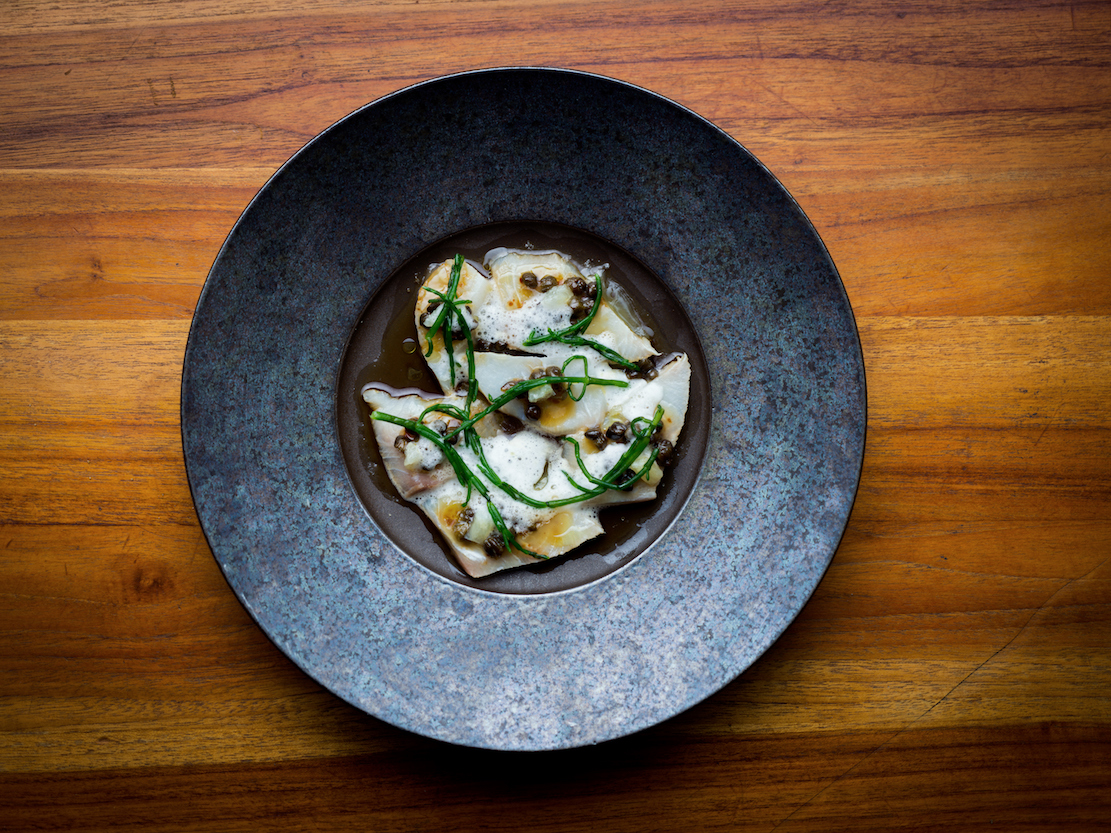 and a branch in
Las Vegas, followed by Mexican concepts in
Chicago and Miami.
and a branch in
Las Vegas, followed by Mexican concepts in
Chicago and Miami.
All these culinary influences inform the
menu at Habitat, the first venture of Mendin’s
Food Comma Hospitality Group, a large, rambling
space that avoids looking like a hotel dining room
by being broken up into a bar and lounge that
leads to the rustic main dining area, as well as
to a much-desired 60-seat outdoor patio. There
are also two private dining areas, The Tambourine
Room and The Wine Lounge.
The menu is ambitious, so the best way to gauge
its range is to go with the seven-course tasting
menu at $90, within which, thankfully, you’ll have
some options, rather than those chosen solely by
the chef. (Otherwise, à la carte prices are high.)
From the raw bar comes
first-rate cobia sashimi (right) graced with brown butter
soy sauce, samphire, lime and “sea water” ($18,)
and a bracing hamachi aguachilies with a
lemongrass romesco, guajilla
peppers, radish and cilantro ($22).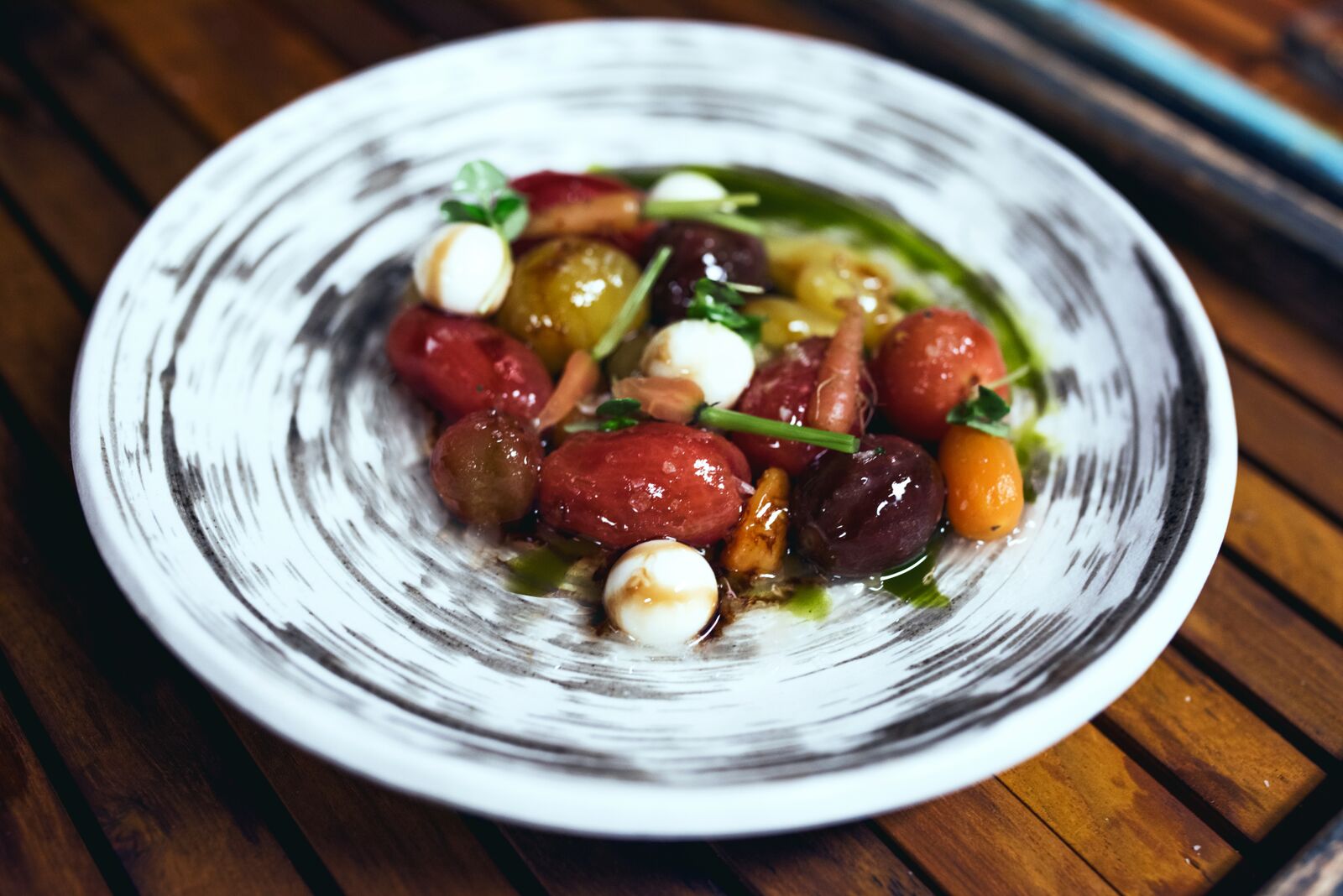 The
Florida stone crabs with a yuzu dijonnaise (market
price) could have been larger and meatier.
The
Florida stone crabs with a yuzu dijonnaise (market
price) could have been larger and meatier.
Ordering a mess of the small plates is a wise
move. Intensely sweet Medjool dates are graced
with a crema
cabrales, almond powder and butiferra
Catalan sausages ($14), while Mendin serves creamy
mozzarella balls (left) with baby tomatoes, sweet
melon, and basil ($16). Silky foie gras takes a
salt cure well, served with tomato chutney and
milk bread ($27).
From the woodfire grill comes tender monkfish—a
species often overcooked—with katsuobushi-flecked
barbecue
sauce, pickled fennel and radish (not cheap at
$55), and a juicy, crisp-skinned baby chicken asado
with aji
panko and lime ($31). Simply
grilled, the langoustines are irresistible ($23).
The skirt steak with shisho
chimichurri is as good as any around town
(but again, not cheap at $55 for ten ounces).
Patricio Sanchez’s desserts include joyously
decadent chocolate s’mores ($14) and “Habitat”
($13) of mint basil financiers, dulcey mousse,
mango and coconut.
Habitat’s
success belies the notion that vacationers in
Miami only want to go with the expected. Few
restaurants around are doing food of this
sophistication and global reach and fewer still
with such flair and imagination based on wide
experience.
Open for breakfast, lunch and dinner daily.
Brunch on weekends.
THE
STRAND BAR & GRILL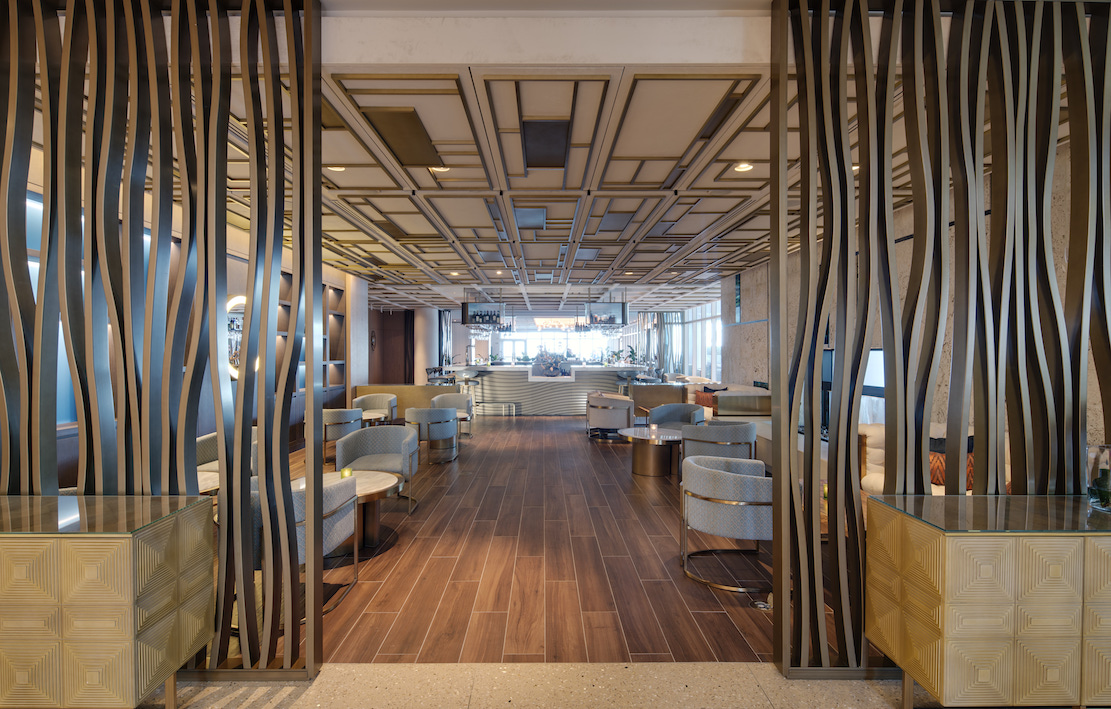
Carillon
Miami
Wellness Resort
6801
Collins
Avenue
305-514-7474
Set
between the hotel lobby and the pool, with the
beach beyond, The Strand Bar & Grill
is a spacious, long room, about half of which is
taken up with a swank, very comfortable bar with a
serious cocktail program (drinks are $14).
Although recently renovated and opened last
Autumn, with soft, sandy colors, potted plants,
banquettes, 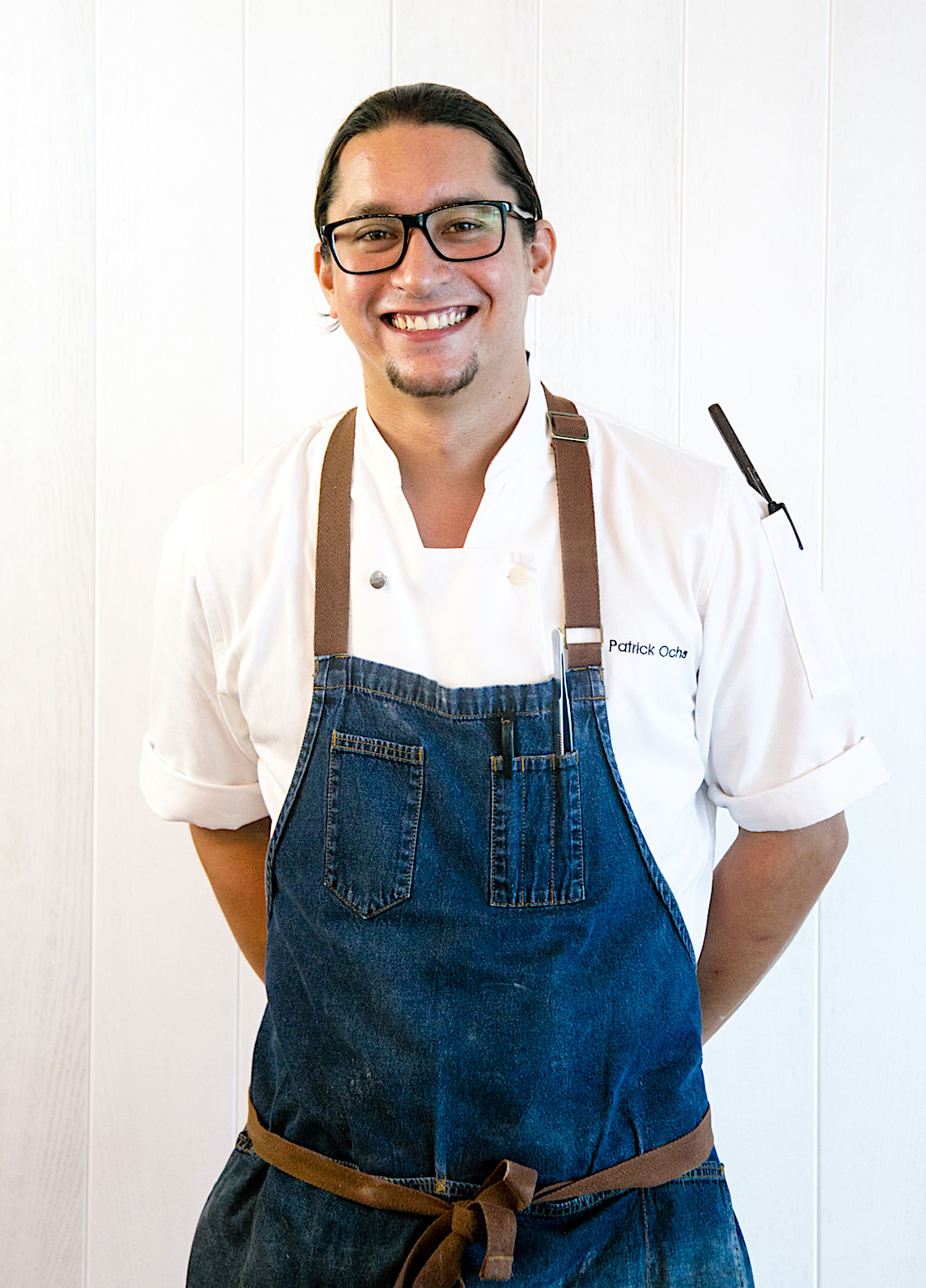 1950s-style
light fixtures and open kitchen, it still has the
feeling of a hotel dining room serving three meals
a day, but I enjoyed the relaxing atmosphere, and
the tables so well set apart from one another.
1950s-style
light fixtures and open kitchen, it still has the
feeling of a hotel dining room serving three meals
a day, but I enjoyed the relaxing atmosphere, and
the tables so well set apart from one another.
Chef Patrick Ochs (left) follows an original chef
who didn’t last out the year, and Ochs has added a
few more of his own ideas to a menu he originally
had a hand in, which is a mix of Floridian cuisine
and an all-American cast meant to please any
appetite. But there’s much you won’t find
elsewhere on South Beach.
For the moment, the menu is broken into raw, one
(appetizers), two (pastas), three (entrees),
grilled, sides and desserts. 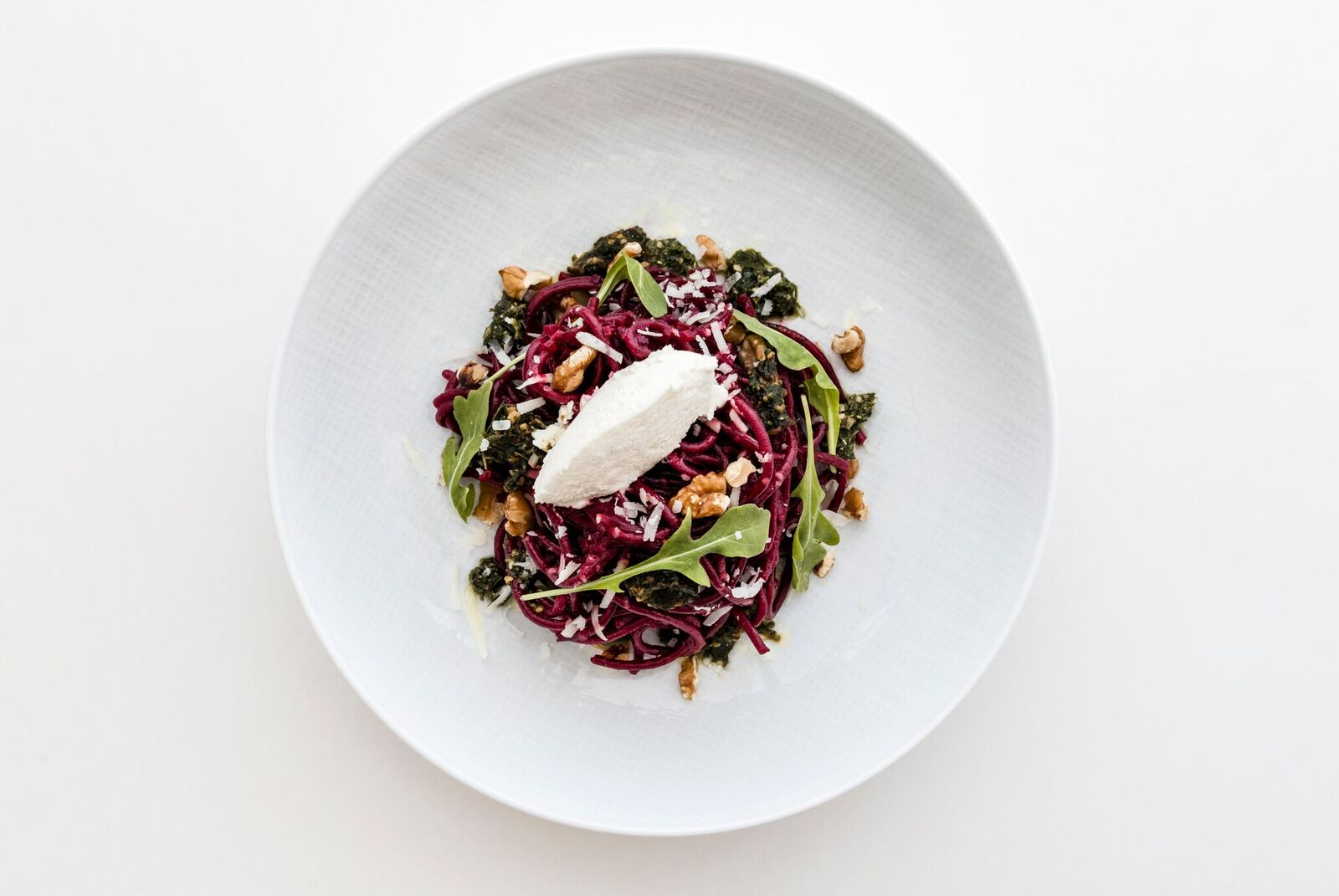 When
I dined there this spring, the best of the first
was the octopus with lightly smoked potato cream,
olives, marble potatoes and smoked paprika
vinaigrette ($27), and I loved the roasted foie
gras with an apple soubise
and a well-conceived hard cider gastrique ($28). Carpaccio
($18) gains little by being wagyu grade; the
provenance is not listed.
When
I dined there this spring, the best of the first
was the octopus with lightly smoked potato cream,
olives, marble potatoes and smoked paprika
vinaigrette ($27), and I loved the roasted foie
gras with an apple soubise
and a well-conceived hard cider gastrique ($28). Carpaccio
($18) gains little by being wagyu grade; the
provenance is not listed.
Ochs
goes just far enough in making his pastas all his
own, adding fava beans, artichokes, cherry
tomatoes and basil to spinach bucatini (right; $19),
and braised rabbit, saffron, dandelion greens and
charred peppers to garganelli ($25).
King crab fettuccine with a sweet-sour gremolata,
tomatoes and lemon-herbed breadcrumbs ($27) was
quite good, but the campanelle
with foraged mushrooms gained nothing from insipid
summer truffles ($21). (Caveat: the current
website menu lists different pasta dishes than
those described here.)
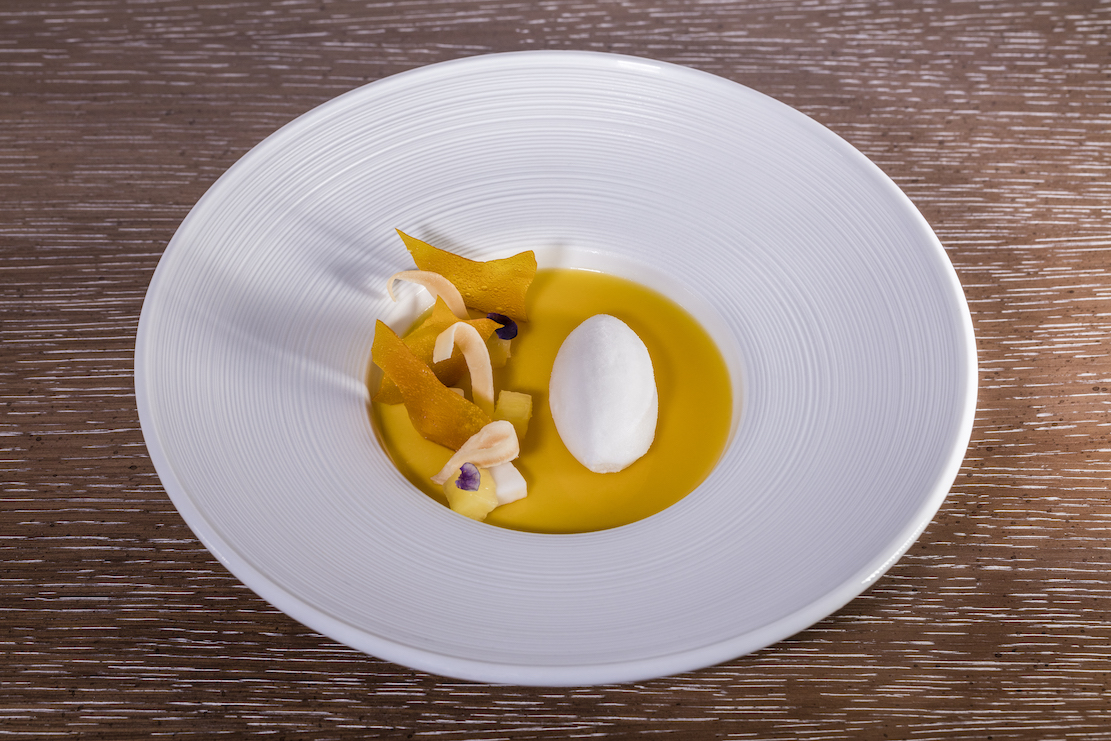 The entrees
are impressively simple: roasted chicken with
asparagus, morels in a vin jaune
reduction ($38), and a terrific smoked duck with
English peas, carrots, luscious foie gras purée
and baby onions ($32). Okay—but not as good as it
might be were it made from American lamb—was a
trio of New Zealand lamb items with smoked yogurt
and za’atar
($38). Branzino,
now ubiquitous on American menus, took on added
flavors from artichoke, eggplant, a confit of
sweet tomato, and a zucchini sofrito ($32). One
has to wonder why, beyond being expected, a farmed
Mediterranean fish—as well as King salmon and
Maine lobster—needs to be on a Florida menu.
The entrees
are impressively simple: roasted chicken with
asparagus, morels in a vin jaune
reduction ($38), and a terrific smoked duck with
English peas, carrots, luscious foie gras purée
and baby onions ($32). Okay—but not as good as it
might be were it made from American lamb—was a
trio of New Zealand lamb items with smoked yogurt
and za’atar
($38). Branzino,
now ubiquitous on American menus, took on added
flavors from artichoke, eggplant, a confit of
sweet tomato, and a zucchini sofrito ($32). One
has to wonder why, beyond being expected, a farmed
Mediterranean fish—as well as King salmon and
Maine lobster—needs to be on a Florida menu.
The coconut panna cotta is
the way to go with dessert (left).
The short wine list is badly in need of expansion.
I hope
Ochs stays right where he is and gets to show more
of his own talents, and I doubly hope the
management can keep the menu prices as reasonable
as they are.
Open
for breakfast, lunch and dinner daily. Brunch on
weekends.
❖❖❖
By John Mariani
AI FIORI
400
Fifth Avenue
212-613-8660
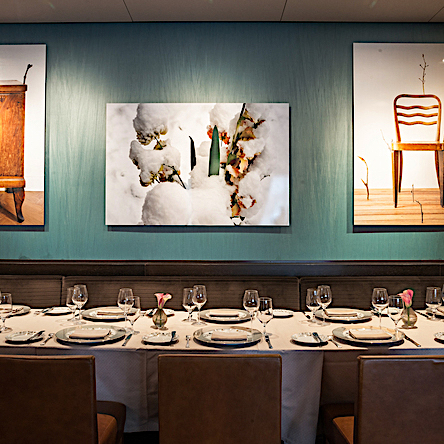
Ai Fiori does not mean “out of the fire” but “among the flowers,” and this enchanting dining room is Chef-owner Michael White’s finest tribute to la cucina italiana.
 That Ohio-born White has achieved so
high a
reputation among New York’s toughest critics would
be remarkable had he come by
his knowledge of Italian food only cooking on this
side of the Tyrrhenian Sea.
But in fact his study for seven years at the
illustrious San Domenico in Imola, Italy,
provided the ballast he needed to do
what he now does so splendidly, equally well at
Ai Fiori in midtown as at the
seafood-centric Marea on the Upper West Side.
That Ohio-born White has achieved so
high a
reputation among New York’s toughest critics would
be remarkable had he come by
his knowledge of Italian food only cooking on this
side of the Tyrrhenian Sea.
But in fact his study for seven years at the
illustrious San Domenico in Imola, Italy,
provided the ballast he needed to do
what he now does so splendidly, equally well at
Ai Fiori in midtown as at the
seafood-centric Marea on the Upper West Side.
True, White’s signature,
via his Altamarea Group, is on far too many
management contracts worldwide,
including restaurants in London, Istanbul and Hong
Kong, which he could hardly
visit with any frequency, but in New York his
high-end ventures and his
lower-end Osteria Morini and Nicoletta pizzeria
have a consistency that
indicates he is a 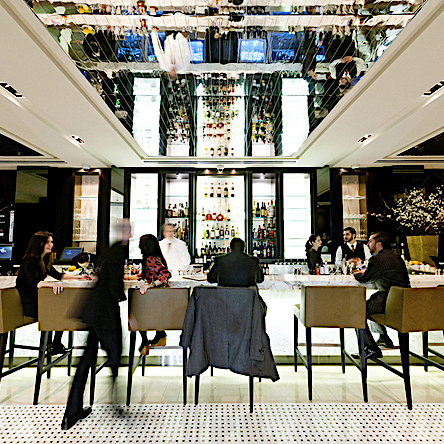 presence
at them.
presence
at them.
Ai Fiori is located up a winding staircase on the second floor of the Langham Hotel, so its separation from the lobby diminishes any sense of being a formulaic hotel dining room. The entire staff also shows no signs of the usual forced attitude of hotel employees.
A superb use of lighting and a tamping down of noise—the tablecloths are nice and thick—has made the dining room as ideal for a business lunch as a celebratory evening, and it’s packed every night, with a surprisingly large contingent of Asian visitors. All women guests dress well; most men make an effort.
Rome-born Wine Director Alessandro Piliego oversees a 1,000-label wine list, with dozens of Champagnes, and the sophisticated Bar Lounge is always crowded. Unfortunately, you’ll look in vain for any white wine priced under $52 or red under $75, and even those are rare.
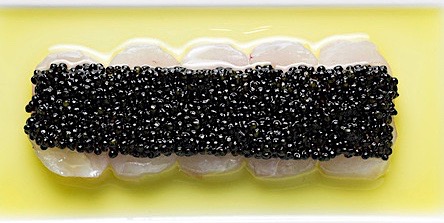 Scott
Schneider has been
Chef di Cucina since June 2016, and he translates
White’s ideas impeccably; his
4-course $108 fixed price menu is quite reasonably
priced, especially since à
la carte prices are very high, with pastas at $37
and too many supplements.
(There are also a 7-course menu at $150 and a
vegetarian menu at $125.)
Scott
Schneider has been
Chef di Cucina since June 2016, and he translates
White’s ideas impeccably; his
4-course $108 fixed price menu is quite reasonably
priced, especially since à
la carte prices are very high, with pastas at $37
and too many supplements.
(There are also a 7-course menu at $150 and a
vegetarian menu at $125.)
You’ll begin with very good
bread and butter, and at my dinner this week an amuse of flawless fluke crudo
with a cucumber pepinato
set on a
silver spoon. A nod toward French cuisine is the
foie gras torchon ($30) that I found oddly
without flavor. There is also a
selection of caviars prettily arrayed on the plate
(left). 
White’s pastas have always leaned towards being very rich and very satisfying—he does not stint on the butter, cheese and cream—the exception being a superb signature item, cavatelli with blue crab, lemon, bottarga roe and a shot of diced chilies. The agnolotti are big and each makes for two mouthfuls, stuffed with ricotta and mascarpone with sottocenere cheese from Veneto and a lushly reduced red wine glaze. Tortelli, filled with braised lamb, mustard greens, pecorino and fennel with a crack of black pepper, are more bite-sized and very good. There is always a risotto; ours came with summer asparagus, chanterelles, prosciutto and Lagrein wine (right).
I am not one who likes long waits between courses, but at Ai Fiori, they are rushing things. Our main courses arrived within one minute of the pasta courses being removed, before we’d even had a chance to savor another sip of wine. They’re not kidding about the meaning of service à la minute.
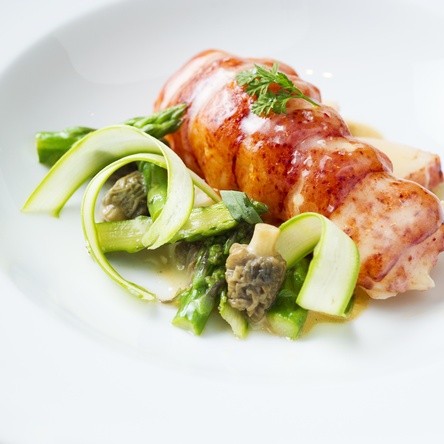 Nevertheless,
there was a
great deal to savor in main courses like the
butter-poached lobster (left) with porcini,
pea leaves, tarragon soubise ($46); the tender
breast of duck with a sweet-sour
mostarda, chicory and ripe blackberries ($44); and
a roast saddle of baby lamb
with al
dente farro, squash and a salsa verde
was a triumph of summery
flavors ($48).
Nevertheless,
there was a
great deal to savor in main courses like the
butter-poached lobster (left) with porcini,
pea leaves, tarragon soubise ($46); the tender
breast of duck with a sweet-sour
mostarda, chicory and ripe blackberries ($44); and
a roast saddle of baby lamb
with al
dente farro, squash and a salsa verde
was a triumph of summery
flavors ($48).
Desserts, all $16, are of
a kind all upscale Italian ristoranti are
now
serving, and Ai Fiori offers several beauties like
a plum semifreddo
on buttermilk cake, lemon crèmeux and
ginger granita; an out-of-the-ordinary
cheesecake tinged with lemon
verbena, olive oil sided with a blueberry gelato;
and a tarteletta
almond cake with
citrus foam and a pomegranate-tarragon sorbetto.
Still, these desserts are so complex that it's not
always easy to discern the main ingredient among
the flash.
I’m glad to see a fine
selection of cheeses offered, three for $18, six
for
$29.
I’ll give the espresso a “B”—when it should have been an “A+.”
While I hate the idea of awarding stars—most food critics do—the fact that the Michelin Guide has never awarded Ai Fiori, now seven years old, more than a single star is consistent with its annual snub of the city’s Italian restaurants. (It was among my choices for Best New Restaurants of the Year in Esquire in 2011.) I would certainly put Ai Fiori in a higher firmament, for the kind of la cucina italiana it serves is available at no more than a handful of Italian restaurants in America. While Marea may get more publicity for its seafood-centric menu, Ai Fiori has a far wider one to entice you.
Open for breakfast, lunch and dinner daily.
❖❖❖
HAVE
THE ITALIAN WINE
REGULATIONS
BECOME A SHAM?
By John Mariani
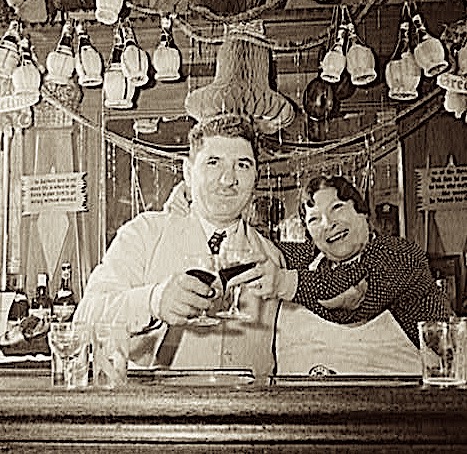
Up until 1963, when
it came to Italian wines it was hard to tell
your Asti from your Elba. Before then, there
were few rules or regulations even overseeing
which wines were made where, much less what
grapes were actually in any given bottle.
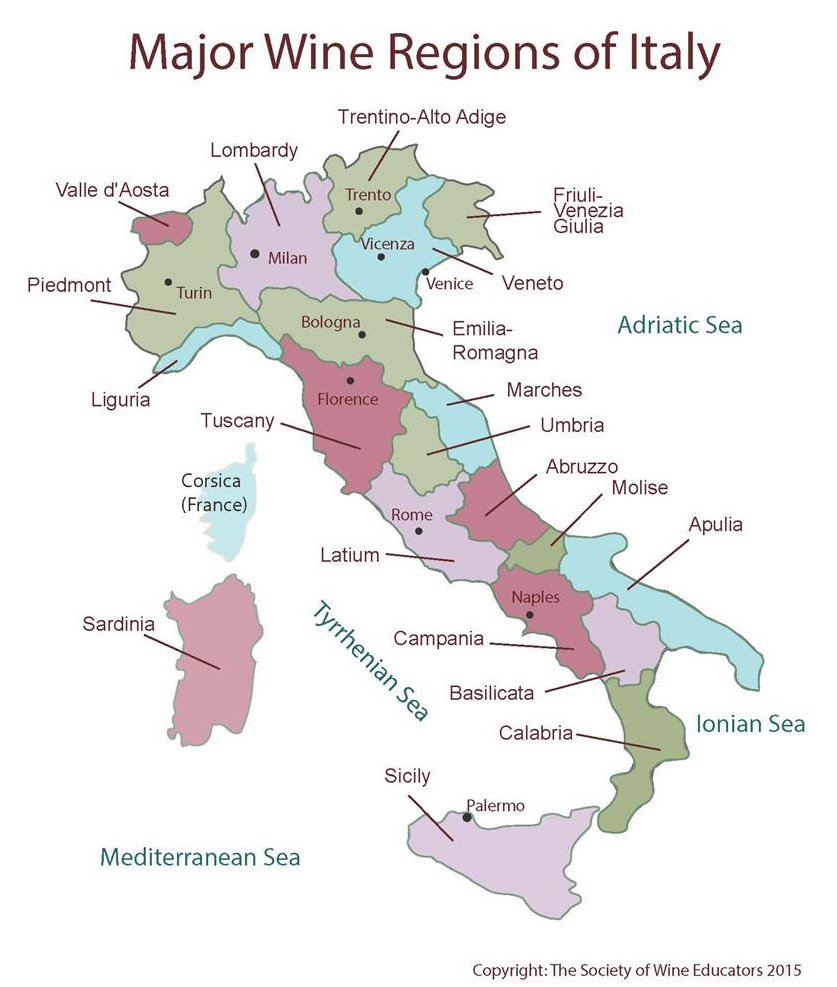 Wineries with
reputations to protect proudly listed their
grapes and their origins on their labels, but
even so, it was not really possible to tell if
anyone was telling the truth. To
make matters worse, for centuries vintners
really did not know what grapes were growing in
their vineyards, because seeds of various grapes
were self propagating—a situation called la coltura
primiscua, or promiscuous cultivation. Ampelography—the
science of grape identification and
classification—was not widely used until well
into the 1950s.
Wineries with
reputations to protect proudly listed their
grapes and their origins on their labels, but
even so, it was not really possible to tell if
anyone was telling the truth. To
make matters worse, for centuries vintners
really did not know what grapes were growing in
their vineyards, because seeds of various grapes
were self propagating—a situation called la coltura
primiscua, or promiscuous cultivation. Ampelography—the
science of grape identification and
classification—was not widely used until well
into the 1950s.
Then, in 1963, under the laws of the European
Union, Italy had to identify and classify its
wine grapes and regions, causing the Italian
Ministry of Agriculture to create two
designations for labels: D.O.C. (denominazione
d’origine controllata: a denomination of
controlled origin) and D.O.C.G., in which the
“G” stood for “garantita” (guarantee). It
was a bureaucratic attempt to make sense of the
maverick way Italians grew grapes and made wine,
and it forced vintners to adhere to strict rules
about which grapes must be used to make a
particular regional wine like, say, Chianti in
Tuscany or Taurasi in Campania.
The appellations that resulted
were remarkably comprehensive and allowed
consumers to find out what they were actually
drinking—a Barolo from Piedmont, a Bardolino
from Veneto or a Marsala from Sicily. The
basic D.O.C. designation made no claims as to
the quality of the wines, except to restrict the
areas in which they could be made. The
D.O.C.G. was an attempt to recognize the finest
wines from the finest regions of Italy and to
guarantee them as such. Originally,
only five wines were so designated—Barolo,
Barbaresco (both Piedmontese), Chianti Classico,
Brunello di Montalcino and Vino Nobile di
Montepulciano (three Tuscans)—all made in
northern regions.
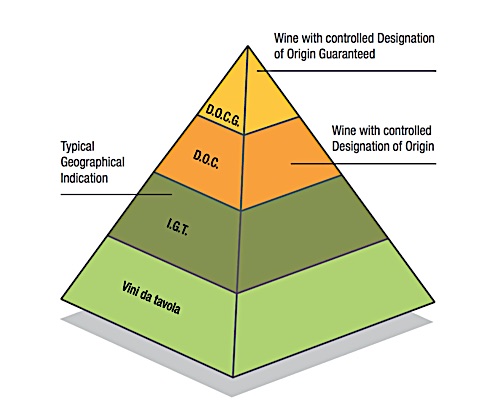
The uproar from other regions was immediate,
and, as things go in Italy, the bureaucrats’
response was to stick the D.O.C.G. appellation
onto dozens of wines from all over Italy. The
issue came to a head in 1986, when Albana di
Romagna,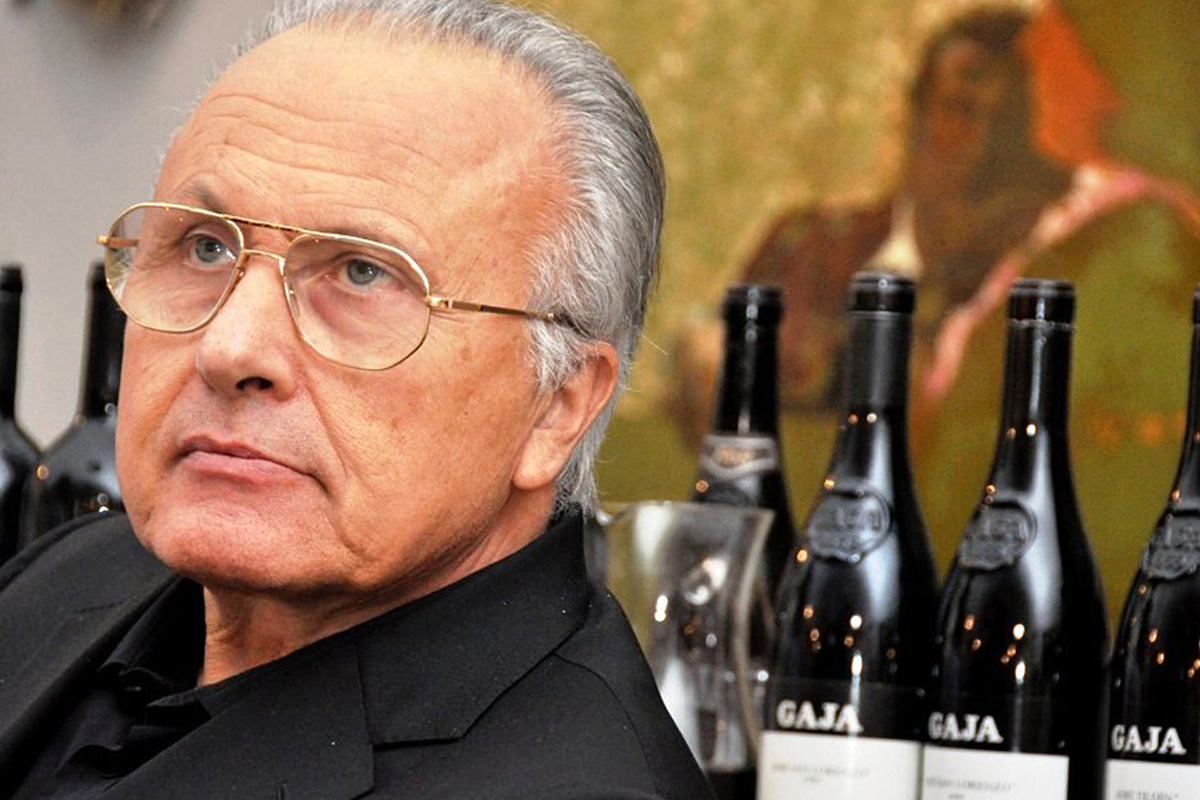 a wine from Emilia
Romagna few Italians had ever heard of much less
tasted, was given a D.O.C.G.; from then on, a
whole slew of mediocre wines have been so
designated, including esoteric wines like Colli
Bolognesi, Rosazzo, Offida, Val
di Cornia and many others. Some of those wines
were made by only a handful of vintners in those
regions. Today
there are an astounding 74 wines that hold a
D.O.C.G.
a wine from Emilia
Romagna few Italians had ever heard of much less
tasted, was given a D.O.C.G.; from then on, a
whole slew of mediocre wines have been so
designated, including esoteric wines like Colli
Bolognesi, Rosazzo, Offida, Val
di Cornia and many others. Some of those wines
were made by only a handful of vintners in those
regions. Today
there are an astounding 74 wines that hold a
D.O.C.G.
Even more of a blow to the integrity of the
D.O.C. and D.O.C.G. appellations were pioneering
and very independent winemakers like Marchese
Piero Antinori (right) of Tuscany and Angelo
Gaja (left)
of Piedmont, who began making wines with grapes
not sanctioned for D.O.C. status within a
region. From
these producers came some extraordinary wines;
in  Tuscany
they were marketed, with no official status, as
“Super Tuscans” like Tignanello and Sassicaia.
But, according to the Italian wine laws, they
could only be labeled as lowest-of-the-low
appellation, vino da
tavola, “table wine.”
Tuscany
they were marketed, with no official status, as
“Super Tuscans” like Tignanello and Sassicaia.
But, according to the Italian wine laws, they
could only be labeled as lowest-of-the-low
appellation, vino da
tavola, “table wine.”
Clearly, this was an embarrassment for the
bureaucrats and an insult to the winemakers,
whose new style wines were in any case winning
international renown and making lots of money
for the producers, without even a D.O.C. As a
result, the Ministry came up with the
designation called Indicazione Geografica
Tipica
(I.G.T.), awkwardly meaning “an indication of
geographic typicality,” but it still did not
guarantee quality.
It all remains a mess.
Obviously, the Italian wine bureaucrats cannot
designate an individual estate like Gaja or
Antinori as a source of one of Italy’s finest
wines, even if connoisseurs and the market
recognize them as such. Instead, it seems the
wine regulators threw up their hands and started
tossing D.O.C.G. appellations to wines with
little or no pedigree, just to satisfy the
industry. Today there are an astounding 74
wines that hold a D.O.C.G.
As a result, while a D.O.C. on the label at
least tells you the wine is made from grapes
grown within an approved region and according to
traditional methods, the D.O.C.G. no longer
tells you much of anything at all. If
you should ever run across a bottle of Rosazzo,
made in the province of Udine, or Colli Euganei
Fior d’Arancio from Padua, drink it and make up
your own mind about its quality. I
daresay you’d have trouble finding a sufficient
number of different bottlings to compare in a
tasting. You may well find you love the wine and
wonder why it’s not better known; or you may
think the stuff is plonk and wonder how the wine
ever got a D.O.C.G.
The way things now work, you’ll
get little help from the bureaucrats in the
Italian Ministry of Agriculture, who seem far
too busy rubber stamping the labels of obscure
wines from regional producers who protested
loudly enough to obtain a once-coveted, though
now discredited, D.O.C.G.
❖❖❖
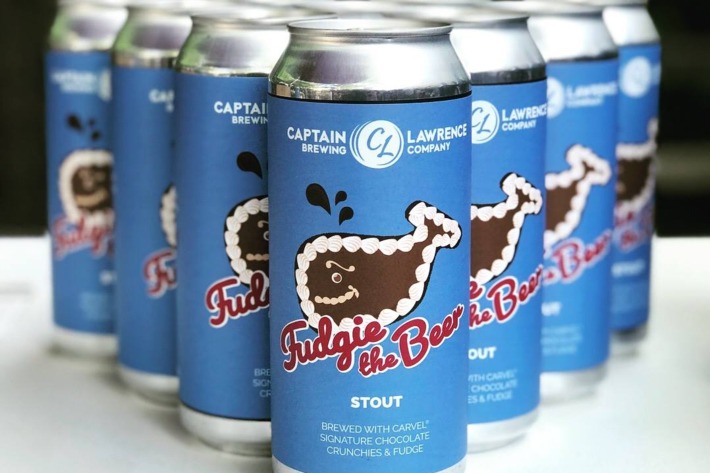 GOD KNOWS WHAT
THEY'LL
GOD KNOWS WHAT
THEY'LL DO WITH THE RUM RAISIN
Fudgie
the
Whale, a Carvel ice cream cake marketed under the
slogan “For a whale of a dad” is now
available through Father's Day as a stout beer
with “hints of Carvel chocolate," called Fudgie the
Beer.

. . . AT LEAST IN WISCONSIN!
Action movie actor Vin Diesel has been accused of stealing a glass dish from an ice cream shop in Hartford, Wisconsin, while in town visiting family. According to the Milwaukee Journal Sentinel, Diesel allegedly visited Scoop DeVille, where he ordered a hot fudge sundae with nuts and whipped cream in an old-fashioned tulip bowl and left the shop with the dish. Owners Carrie and Ray Stelzer told the outlet that he’s welcome to keep the dish as a souvenir.
Wine Column Sponsored by Banfi Vintners
SANGIOVESE
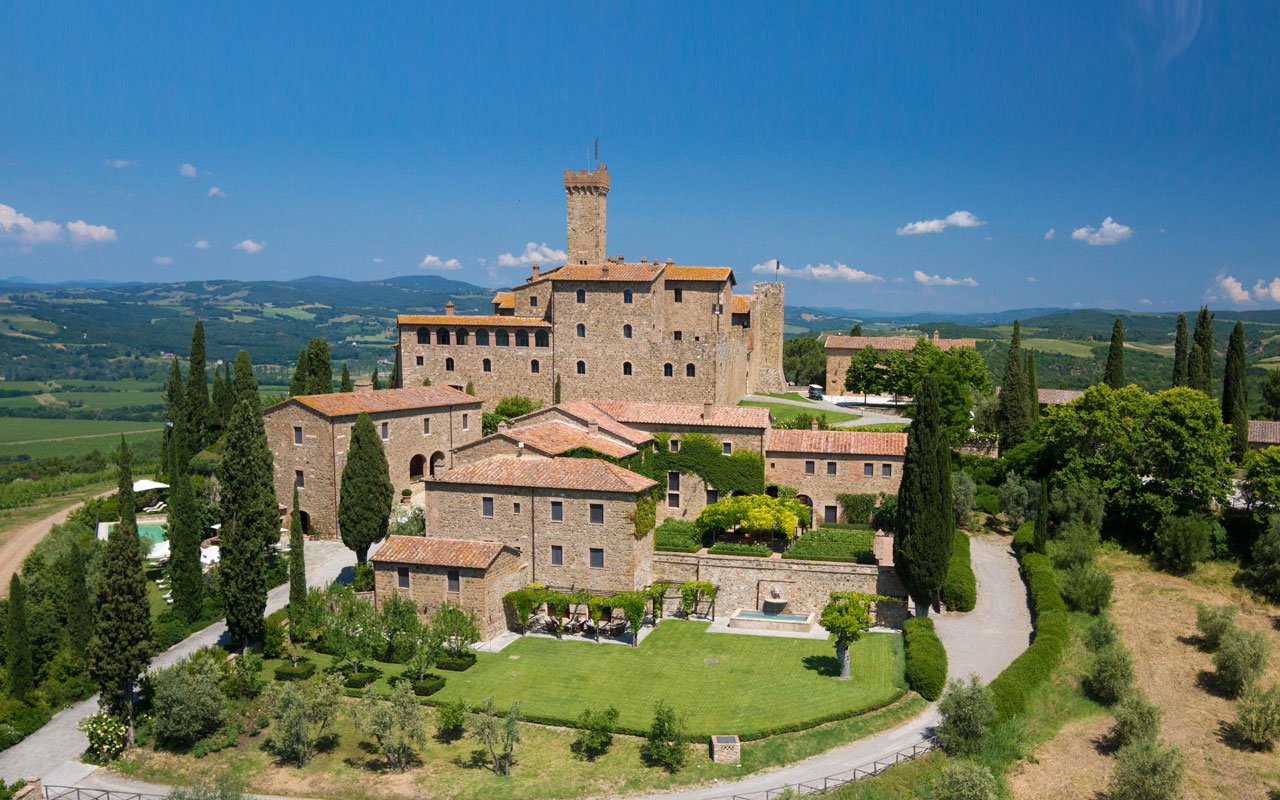 Wine is a joy year-round but
in cooler weather one
grape varietal has really taken center stage in
my daily activities – that most Italian of
grapes, Sangiovese, and its ultimate expression
– Brunello di Montalcino.
Wine is a joy year-round but
in cooler weather one
grape varietal has really taken center stage in
my daily activities – that most Italian of
grapes, Sangiovese, and its ultimate expression
– Brunello di Montalcino.
From mid-September through mid-October,
the Sangiovese grown for our various styles of red
wines are be harvested, culminating with the top
selection for Brunello di Montalcino.
Second, cooler weather here means
it is time to start enjoying more red wines and
especially Sangiovese based wines. That
includes Banfi’s cru of Brunello, Poggio alle Mura,
literally the cream of the crop of our Sangiovese
vineyards. Alongside our Poggio alle Mura Brunello di
Montalcino, this year we introduced two more wines
from the cru Poggio alle Mura – a Rosso di Montalcino
and a Riserva of Brunello. Rosso is sort of like the
younger brother of Brunello, also made from 100%
Sangiovese grapes but usually a selection from younger
vines and the wine is aged only two years compared to
the four required for Brunello. The
Riserva, on the other hand, is an even more selective
harvest of Sangiovese, and ages for an additional year
before release.
What is so special about this cru
Poggio alle Mura?
Well, it is the result our over 30 years of
ongoing research at my family’s vineyard estate,
Castello Banfi.
When we first began planting our vines there in
the late 1970s studies from the University of Bordeaux
indicated which strains of many varietals we should
plant, based on the soil type and microclimate of each
vineyard. But
when it came to the region’s native Sangiovese, there
was only local lore, no scientific research. So we took
it upon ourselves to figure out this vine, and set off
on three decades of incredibly detailed research.
We started
with 600 apparent variations on Sangiovese, because it
is so susceptible to variations in weather and soil,
and narrowed that down to 160 truly genetically
different clones.
We planted a vineyard with two rows of each
type, made wine from each of them, and charted the
differences – remember, you only get one chance a year
to make wine, so this took time.
It took about ten years to get some
concrete results, though we continue to experiment
today and always will – you never stop learning in
science and nature!
Once we determined which were the best,
complementary clones that could be planted together to
make the best Brunello, we chose to plant them in what
we determined to be the optimal vineyard sites. Coincidentally,
the best soils and climate conditions are in the
slopes surrounding the medieval fortress today known
as Castello Banfi, known since Etruscan times as
Poggio alle Mura – the walled hilltop. Hence the
name of our most special “cru” of Brunello,
representing a synthesis between tradition and
innovation.
Though the focus of this study was
our Brunello, all of our Sangiovese-based wines,
including the super Tuscans SummuS, Cum Laude, and
Centine, benefitted from this work. And that’s
the third reason for celebrating Sangiovese this
month, for the range of wonderful reds that usher us
into autumn! One
wine in particular was inspired by our research – the
BelnerO, a Sangiovese dominant blend with what I like
to call a kiss of Cabernet and a whisper of Merlot. We grow the
grapes a little differently for BelnerO than for
Brunello, make the wine with less oak aging and
released it earlier from the winery, providing a
counterpoint to Brunello and a lovely terroir-driven
wine in its own right.
If you
know Italians, you know that by nature we are
multi-faceted, varying in mood, and always passionate. As a
nation, we span from the hot sunny beaches of Sicily
near the African coast to the rugged mountains and
Alpine ski slopes of Trentino-Alto Adige in the north. Sangiovese
is grown in almost all of Italy’s regions and reflects
the unique nature of each; it is most famous
(rightfully so) in Tuscany, yet even there it reflects
the nuances of each hilltop, valley and subzone. It has
something a little different to say in Brunello than
Chianti, Morellino than Vino Nobile di Montepulciano,
Rosso di Montalcino than Super Tuscan blends.
Here is a smattering of
Sangiovese-based wines that you may wish to get to
know better, reflecting a spectrum that appeals to
every occasion, every taste, and every budget. We can
assure you that the conversation will never become
boring. 
Recommendations for Celebrating
Sangiovese
BelnerO Proprietor’s Reserve Sangiovese
– A refined
cuvée of noble red grapes perfected by our pioneering
clonal research. This dark beauty, BelnerO, is
produced at our innovative winery, chosen 11
consecutive years as Italy’s Premier Vineyard Estate.
Fermented in our patented temperature controlled
French oak and aged approximately 2 additional years.
Unfiltered, and Nitrogen bottled to minimize sulfites.
Castello Banfi Brunello di Montalcino –
Rich, round, velvety and intensely
aromatic, with flavor hints of licorice, cherry, and
spices. Brunello di Montalcino possesses an intense
ruby-red color, and a depth, complexity and opulence
that is softened by an elegant, lingering aftertaste.
Unfiltered after 1998 vintage.
Castello Banfi Rosso di Montalcino – Brunello's "younger brother," produced
from select Sangiovese grapes and aged in barrique for
10 to 12 months. Deep ruby-red, elegant, vibrant,
well-balanced and stylish with a dry velvety
finish.
Poggio all’Oro Brunello di Montalcino
Riserva – A single vineyard selection of our most
historically outstanding Sangiovese, aged five years
before release, the additional year more than that
required of Brunello including 6 months in barrel and
6 months more in bottle to grant its “Riserva”
designation. Incredible
elegance and harmony. Intense with lots of fruit and
subtle wood influence. Round, complete, well balanced
with hints of chocolate and berries. Unfiltered after
1998.
Poggio alle Mura – The first tangible result of years of
intensive clonal research on Montalcino’s native
Sangiovese grape.
Estate bottled from the splendidly sun drenched
vineyards surrounding the medieval Castello from which
it takes its name.
The Brunello
di Montalcino is seductive, silky and smoky. Deep ruby
in color with an expressive bouquet of violets, fruits
and berries as well as cigar box, cedar and exotic
spices. The Rosso
di Montalcino is also intense ruby red. The bouquet
is fresh and fruity with typical varietal notes of
cherry and blackberry, enriched by more complex hints
of licorice, tobacco and hazelnut. It is full
bodied, yet with a soft structure, and a surprisingly
long finish. The Poggio alle Mura Brunello di Montalcino
Riserva is deep ruby red with garnet
reflections and a rich, ample bouquet that hints of
prune jam, coffee, cacao and a light balsamic note. It is full
and powerful, with ripe and gentle tannins that make
it velvety and harmonious; this wine is supported by a
pleasing minerality that to me speaks soundly of that
special hillside in southern Montalcino.
SummuS – A wine of towering elegance, SummuS is an
extraordinary blend of Sangiovese which contributes
body; Cabernet Sauvignon for fruit and structure; and
Syrah for elegance, character and a fruity bouquet. An elegant,
complex and harmonious red wine.
Cum Laude – A complex and elegant red which graduated
“With Honors,” characterized by aromas of juicy
berries and fresh spices.
Centine – A Cuvee that is more than half
Sangiovese, the balanced consisting of equal parts of
Cabernet Sauvignon and Merlot. Vinified in
a firm, round style that easily accompanies a wide
range of dishes, this is a smooth and fragrantly
satisfying wine with international character, and a
perennial favorite at my own dinner table.
Banfi Chianti Superiore – The “Superiore” designation signifies
stricter government regulations regarding production
and aging requirements, as compared to regular
Chianti. An
intense ruby red wine with fruit forward aromas and
floral notes. This
is a round wine with well-balanced acidity and fruit.
Banfi Chianti Classico – An enduring classic: alluring
bouquet of black fruit and violets; rich flavors of
cherry and leather; supple tannins and good acidity
for dining.
Banfi Chianti Classico Riserva – Produced from select grapes grown in the
"Classico" region of Chianti, this dry, fruity and
well-balanced red has a full bouquet reminiscent of
violets.
Fonte alla Selva Chianti Classico – This is our newest entry into the Chianti
arena, coming from a 99 acre estate in Castellina, the
heart of the Chianti Classico region. The wine is
a captivating mauve red that smells of cherry, plum
and blackberry with hints of spice. It is
round, full and balanced with very good
acidity.
Col di Sasso – Sangiovese and Cabernet Sauvignon. Luscious,
complex and soft with persistent notes of fruit and
great Italian style structure.
Any of John Mariani's books below may be ordered from amazon.com.
 The Hound in Heaven
(21st Century Lion Books) is a novella, and
for anyone who loves dogs, Christmas, romance,
inspiration, even the supernatural, I hope you'll find
this to be a treasured favorite. The story
concerns how, after a New England teacher, his wife and
their two daughters adopt a stray puppy found in their
barn in northern Maine, their lives seem full of promise.
But when tragedy strikes, their wonderful dog Lazarus and
the spirit of Christmas are the only things that may bring
his master back from the edge of despair.
The Hound in Heaven
(21st Century Lion Books) is a novella, and
for anyone who loves dogs, Christmas, romance,
inspiration, even the supernatural, I hope you'll find
this to be a treasured favorite. The story
concerns how, after a New England teacher, his wife and
their two daughters adopt a stray puppy found in their
barn in northern Maine, their lives seem full of promise.
But when tragedy strikes, their wonderful dog Lazarus and
the spirit of Christmas are the only things that may bring
his master back from the edge of despair. WATCH THE VIDEO!
“What a huge surprise turn this story took! I was completely stunned! I truly enjoyed this book and its message.” – Actress Ali MacGraw
“He had me at Page One. The amount of heart, human insight, soul searching, and deft literary strength that John Mariani pours into this airtight novella is vertigo-inducing. Perhaps ‘wow’ would be the best comment.” – James Dalessandro, author of Bohemian Heart and 1906.
“John Mariani’s Hound in Heaven starts with a well-painted portrayal of an American family, along with the requisite dog. A surprise event flips the action of the novel and captures us for a voyage leading to a hopeful and heart-warming message. A page turning, one sitting read, it’s the perfect antidote for the winter and promotion of holiday celebration.” – Ann Pearlman, author of The Christmas Cookie Club and A Gift for my Sister.
“John Mariani’s concise, achingly beautiful novella pulls a literary rabbit out of a hat – a mash-up of the cosmic and the intimate, the tragic and the heart-warming – a Christmas tale for all ages, and all faiths. Read it to your children, read it to yourself… but read it. Early and often. Highly recommended.” – Jay Bonansinga, New York Times bestselling author of Pinkerton’s War, The Sinking of The Eastland, and The Walking Dead: The Road To Woodbury.
“Amazing things happen when you open your heart to an animal. The Hound in Heaven delivers a powerful story of healing that is forged in the spiritual relationship between a man and his best friend. The book brings a message of hope that can enrich our images of family, love, and loss.” – Dr. Barbara Royal, author of The Royal Treatment.
 |
The Encyclopedia of American Food and Drink by John F. Mariani (Bloomsbury USA, $35) Modesty forbids me to praise my own new book, but let me proudly say that it is an extensive revision of the 4th edition that appeared more than a decade ago, before locavores, molecular cuisine, modernist cuisine, the Food Network and so much more, now included. Word origins have been completely updated, as have per capita consumption and production stats. Most important, for the first time since publication in the 1980s, the book includes more than 100 biographies of Americans who have changed the way we cook, eat and drink -- from Fannie Farmer and Julia Child to Robert Mondavi and Thomas Keller. "This book is amazing! It has entries for everything from `abalone' to `zwieback,' plus more than 500 recipes for classic American dishes and drinks."--Devra First, The Boston Globe. "Much needed in any kitchen library."--Bon Appetit. |
"Eating Italian will never be the same after reading John Mariani's entertaining and savory gastronomical history of the cuisine of Italy and how it won over appetites worldwide. . . . This book is such a tasteful narrative that it will literally make you hungry for Italian food and arouse your appetite for gastronomical history."--Don Oldenburg, USA Today. "Italian
restaurants--some good, some glitzy--far
outnumber their French rivals. Many of
these establishments are zestfully described
in How Italian Food Conquered the World, an
entertaining and fact-filled chronicle by
food-and-wine correspondent John F.
Mariani."--Aram Bakshian Jr., Wall Street
Journal.
"Equal parts
history, sociology, gastronomy, and just
plain fun, How Italian Food Conquered the
World tells the captivating and delicious
story of the (let's face it) everybody's
favorite cuisine with clarity, verve and
more than one surprise."--Colman Andrews,
editorial director of The Daily
Meal.com. "A fantastic and fascinating
read, covering everything from the influence
of Venice's spice trade to the impact of
Italian immigrants in America and the
evolution of alta cucina. This book will
serve as a terrific resource to anyone
interested in the real story of Italian
food."--Mary Ann Esposito, host of PBS-TV's
Ciao
Italia. "John Mariani has written the
definitive history of how Italians won their
way into our hearts, minds, and
stomachs. It's a story of pleasure over
pomp and taste over technique."--Danny Meyer,
owner of NYC restaurants Union Square
Cafe, The Modern, and Maialino.
|
 |
 |
 |
 |
 |
 |
 |
 |
 Everett Potter's Travel Report:
Everett Potter's Travel Report: 
 Eating Las Vegas
JOHN CURTAS has been covering the Las Vegas
food and restaurant scene since 1995. He is
the co-author of EATING LAS VEGAS – The 50
Essential Restaurants (as well as
the author of the Eating Las Vegas web site: www.eatinglasvegas.
He can also be seen every Friday morning as
the “resident foodie” for Wake Up With the
Wagners on KSNV TV (NBC) Channel 3 in
Las Vegas.
Eating Las Vegas
JOHN CURTAS has been covering the Las Vegas
food and restaurant scene since 1995. He is
the co-author of EATING LAS VEGAS – The 50
Essential Restaurants (as well as
the author of the Eating Las Vegas web site: www.eatinglasvegas.
He can also be seen every Friday morning as
the “resident foodie” for Wake Up With the
Wagners on KSNV TV (NBC) Channel 3 in
Las Vegas.
MARIANI'S VIRTUAL GOURMET
NEWSLETTER is published weekly. Publisher: John Mariani. Editor: Walter Bagley. Contributing Writers: Christopher Mariani,
Robert Mariani, Misha Mariani, John A. Curtas, Gerry Dawes, Geoff Kalish,
and Brian Freedman. Contributing
Photographer: Galina Dargery. Technical
Advisor: Gerry
McLoughlin.
If you wish to subscribe to this
newsletter, please click here: http://www.johnmariani.com/subscribe/index.html
© copyright John Mariani 2017

